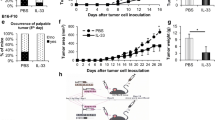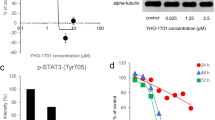Abstract
The role of different tilorone analogs in the abrogation of the metastatic spread of H-2 positive and H-2 negative tumor clones was studied. Pre-treatment of BALB/c mice with RMI 10,874DA compound completely abolished lung colonization of an H-2 negative (GR9.B9) MCA-induced fibrosarcoma clone in an experimental metastasis assay. This effect was also evident when clones were treated with other tilorone analogs (R11,567DA or R11,513DA). Other H-2 positive and H-2 negative chemically induced fibrosarcoma clones were also tested. The effect was not due to direct toxicity of the tilorone analog on tumor cells, but instead was dependent on NK cells; this was suggested by the finding that treatment of mice with anti-asialo GM1 abrogated the effect of the tilorone analog (RMI 10,874DA compound). Interestingly, the inhibition of lung colonization after intravenous injection was again observed regardless of the H-2 phenotype of the tumor clones, and H-2+ and H-2− clones were similarly inhibited.In vitro assays of NK sensitivity of tumor clones showed that lysis varied depending on the H-2 phenotype of tumor clones, indicating an absence of correlation betweenin vivo andin vitro results.
Similar content being viewed by others
References
Poste G and Fidler IJ, 1980, The pathogenesis of cancer metastasis.Nature,283, 139–145.
Nicolson GL, 1982, Cancer metastasis; organ colonization and the cell-surface properties of malignant cells.Biochimica et Biophysica Acta,695, 113–173.
Schirrmacher V, 1985, Cancer metastasis: Experimental approaches, theoretical concepts, and impacts for treatment strategies.Advances in Cancer Research,43, 1–71.
Axelrad A and Klein G, 1956, Differences in histocompatibility requirements between primary tumors and their metastasis.Transplantation Bulletin,3, 100–107.
Haywood GR and McKhann CF, 1971, Antigenic specificities on murine sarcoma cells: reciprocal relationship between normal transplantation antigens (H-2) and tumor-specific immunogenicity.Journal of Experimental Medicine,133, 1171–1187.
Ruiz-Cabello F, Klein E and Garrido F, 1991, MHC antigens in human tumors.Immunology Letters,29, 181–190.
Garrido F and Klein E, 1991, MHC antigen expression I. Human tumors. In: Klein E and Garrido F (eds.)Seminars in Cancer Biology, vol 2-1. Philadelphia: Saunders Scientific Publications, pp. 1–2.
Festenstein H, 1987, The biological consequences of altered MHC expression on tumors.British Medical Bulletin,43, 217–227.
Eisenbach L, Segal S and Feldman M, 1983, MHC imbalance and metastatic spread in Lewis lung carcinoma clones.International Journal of Cancer,32, 113–120.
Ljunggren HG and Kärre K, 1990, In search of the ‘missing self’: MHC molecules and NK cell recognition.Immunology Today,11, 237–244.
Moretta L, Ciccone E, Moretta A, Höglund P, Öhlen C and Kärre K, 1992, Allorecognition by NK cells: nonself or no self?Immunology Today,13, 300–306.
Adamson RH, 1971, Antitumor activity of tilorone hydrochloride against some rodent tumors: Preliminary report.Journal of the National Cancer Institute,46, 431–438.
Albrecht WL, 1977, Tilorone and analogs: physicochemical and antiviral properties. In: Chirigos MA (ed.)Modulation of Host Immune Resistance in the Prevention or Treatment of Induced Neoplasm. Fogarty International Cancer Proceedings, No. 28, Washington, US Government printing office, pp. 83–87.
Mayer GD and Krueger RF, 1970, Tilorone hydrochloride: Mode of action.Science,169, 1214–1215.
Munson AE, Munson JA, Regelson W and Wampler GL, 1972, Effect of tilorone hydrochloride and congeners on reticuloendothelial systems. Tumor and immune response.Cancer Research,32, 1397–1403.
Wampler GL, Munson AE and Regelson W, 1972, Tilorone and congeners: New antitumor agents with stimulating effects on host defense mechanism.Proceedings of the American Association for Cancer Research,13, 120–122.
Wampler GL and Regelson W, 1977, Antitumor activity of tilorone and congeners in murine screening tumor systems. In: Chirigos MA (ed.)Modulation of Host Immune Resistance in the Prevention or Treatment of Induced Neoplasm. Fogarty International Cancer Proceedings, No. 28, Washington, Government printing office, pp. 123–129.
Algarra I, Pérez M, Gasca F, Gaforio JJ and Garrido F, 1992, Generation and control of metastasis in experimental tumor systems.Clinical and Experimental Metastasis,10, 38–39.
Algarra I, Pérez M, Höglund P, Gaforio JJ, Ljunggren HG and Garrido F, 1993, Generation and control of metastasis in experimental tumor systems; inhibition of experimental metastases by a tilorone analogue.International Journal of Cancer,54, 518–523.
Pérez M, Garrido A, Algarra I and Garrido F, 1985, Different H-2 phenotypes in clones derived from a new BALB/c solid tumor. Its relevance for local tumor growth.Immunología,4, 60–69.
Garrido A, Pérez M, Delgado C, Garrido ML, Rojano J, Algarra L and Garrido F, 1986, Influence of class I H-2 gene expression on local tumor growth.Experimental and Clinical Immunogenetics,13, 98–110.
Algarra I, Öhlen C, Pérez M, Ljunggren HG, Klein G, Garrido F and Kärre K, 1989, NK sensitivity and lung clearance of MHC class I deficient cells within a heterogeneous fibrosarcoma.International Journal of Cancer,44, 675–680.
Pérez M, Algarra I, Ljunggren HG, Caballero A, Mialdea MJ, Gaforio JJ, Klein G, Kärre K and Garrido F, 1990, A weakly tumorigenic phenotype with high MHC class I expression is associated with high metastatic potential after surgical removal of the primary murine fibrosarcoma.International Journal of Cancer,46, 258–261.
Algarra I, Gaforio JJ, Garrido A, Mialdea MJ, Perez M and Garrido F, 1991, Heterogeneity of MHC-class I antigens in clones of methylcholanthrene induced tumors. Implications for local growth and metastasis.International Journal of Cancer (Suppl)6, 73–81.
Gaforio JJ, Perez M, Algarra I, Mialdea JJ, Ljunggren HG and Garrido F, 1991, Differential mRNA levels of c-myc, c-fos and MHC class I in several clones of a murine fibrosarcoma.International Journal of Cancer,49, 1–5.
Mule JJ, Yang JC, Lafreniere R, Shu S and Rosenberg SA, 1987, Identification of cellular mechanisms operationalin vivo during the regression of established pulmonary metastases by the systemic administration of high-dose recombinant interleukin 2.Journal of Immunology,139, 285–294.
Barlozzari T, Leonhardt J, Wiltrout RH, Heberman RB and Reynolds CW, 1985, Direct evidence for the role of LGL in the inhibition of experimental tumor metastases.Journal of Immunology,134, 2783–2789.
Gorelik E, Wiltrout RH, Okumura K, Habu S and Heberman RB, 1982, Role of NK cells in the control of metastatic spread and growth of tumor cells in mice.International Journal of Cancer,30, 107–112.
Hanna N, 1982, Inhibition of experimental tumor metastasis by selective activation of natural killer cells.Cancer Research,42, 1337–1342.
Heberman RB, Nunn MG and Lavrin DH, 1975, Natural cytotoxic reactivity of mouse lymphoid cells against syngeneic and allogeneic tumors. I. Distribution of reactivity and specificity.International Journal of Cancer,16, 216–229.
Wiltrout RH, Heberman RB, Zhang SR, Chirigos MA, Ortaldo JR, Green KM and Talmadge JE, 1985, Role of organ-associated NK cells in decreased formation of experimental metastases in lung and liver.Journal of Immunology,134, 4267–4275.
Papa MZ, Mule JJ and Rosenberg SA, 1986, Antitumor efficacy of lymphokine-activated killer cells and recombinant interleukin 2in vivo: successful immunotherapy of established pulmonary metastases from weakly immunogenic and nonimmunogenic murine tumors of three distinct histological types.Cancer Research,46, 4973–4978.
Toshitani A, Taniguchi K, Kawano Y and Nomoto K, 1987, Inverse relationship in H-2 associated lysis between NK cells and rIL-2 activated killer cells: Evidence fromin vitro killing and metastatic experiments.Cellular Immunology,108, 188–202.
Author information
Authors and Affiliations
Rights and permissions
About this article
Cite this article
Algarra, I., Pérez, M., Gaforio, J.J. et al. In vivo activation of NK cells induces inhibition of lung colonization of H-2 positive and H-2 negative fibrosarcoma tumor clones. Clin Exp Metast 12, 31–36 (1994). https://doi.org/10.1007/BF01784331
Received:
Accepted:
Issue Date:
DOI: https://doi.org/10.1007/BF01784331




